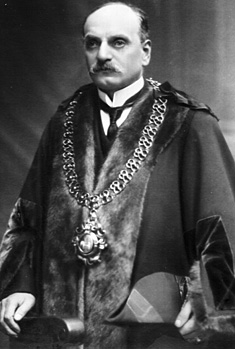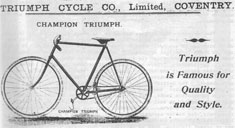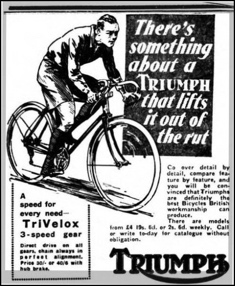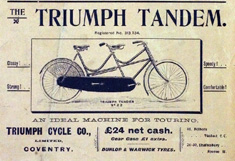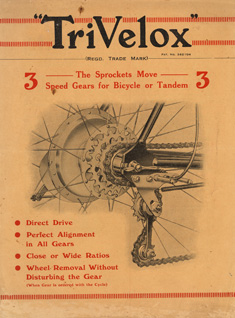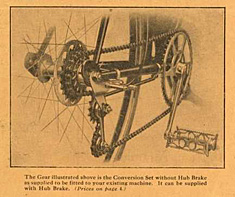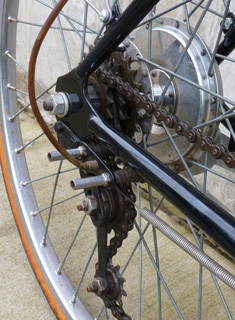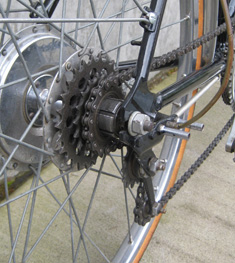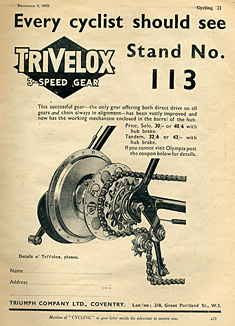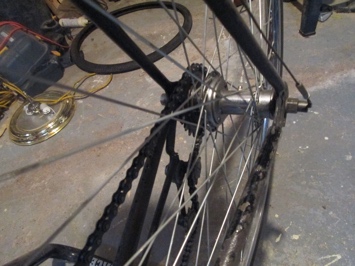Triumph Company
The early days of Triumph are very much the story of one man, the Nuremberg-born Siegfried Bettmann (1863-1951). Bettmann was a very important figure in the history of Coventry: not only was he the founder of the Triumph Company he was also mayor of the city in 1913 [1].
In 1883 Bettmann moved from Germany to England, and by 1885 he was selling bicycles for export through his London-based business, S. Bettmann & Company. The bicycles were made in the English Midlands, but they had Bettmann's name on them. During the next two years there were two significant developments: first the name of the business was changed to the Triumph Cycle Company, later to become the Triumph Cycle Company Limited; and second Bettmann was joined by a junior partner, Mauritz Shulte, who was a trained engineer. Shulte convinced Bettmann the company should manufacture its own bicycles and so the partners rented what was possibly a disused ribbon-making factory in Much Park Street, Coventry, and began producing Triumph-branded bicycles from there in about 1889. In those days, of course, Coventry was at the heart of the British bicycle industry [2].
In 1902 the company began to manufacture motorcycles, and in 1907 - other sources say 1894 - the company moved into larger premises in Priory Street. Some sources state the new premises were purpose-built, others that the building was an old mill [3].
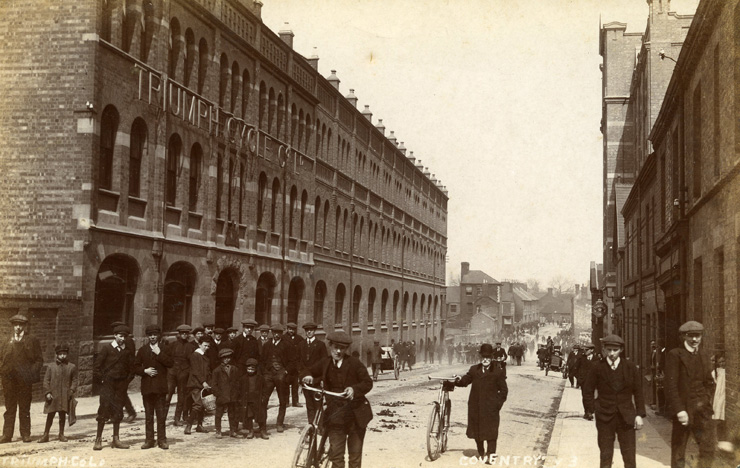
Photograph of Triumph factory in Priory Street, courtesy of David Fry
In the early 1920s Bettmann was persuaded by his then general manager, Claude Holbrook, to acquire the assets and Clay Lane premises of the Dawson Car Company of Coventry: and in 1923 what was to become the Triumph Motor Company Limited began to produce a car named the Triumph 10/20. This was possibly the model of car that Alec Shuttleworth, the joint-patentee of the TriVelox gear, was photographed standing on in the late 1920s or early 1930s.
When Triumph started manufacturing the TriVelox gear in about 1932 it was in its Priory Street factory [4]. A brochure for the gear, probably published by Triumph in 1934 or early 1935 - it mentions a 1934 model of tandem - gives the name and address of the company as Triumph Company Ltd, Priory Street, Coventry. (The word 'Cycle' had been removed from the company's name in the early 1930s.)
The gear pictured on the cover looks essentially the same as the sketch of the gear provided in the 1931 patent application (382,104). For example it shows the gear fitted to a bicycle with rear-facing drop-outs and the cable for changing gear enters from the off-side. But given that the majority of bicycles were made with front-facing drop-outs, the company also offered a conversion set, with or without a hub brake, that could be fitted to an existing machine. (The complete brochure can be viewed on Mike Sweatman's Disraeli Gears website)
There is an excellent description and photograph of a BSA T64 tandem fitted with the above model of TriVelox gear on the web site of the Classic Cycle bicycle shop of Bainbridge Island, Washington State, USA: this tandem may be viewed here. The two close-up photographs of its gear are courtesy of Classic Cycle. Below is a video that shows the gear in action. (A slow motion segment of the video can be viewed here.)
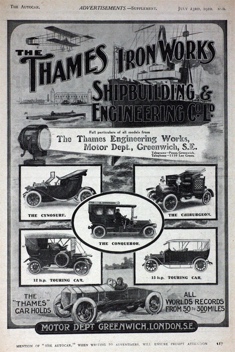
1910 advertisement for the Motor Department of the Thames Engineering Works, courtesy of Grace's Guide
About the same time that Triumph began manufacturing the TriVelox gear the company recruited the famous motorcycle engineer Val Page (1891-1978) to its ranks. Valentine Page, who was born in Hackney, was the son of a sometime mayor of Ipswich with the same given name. This creates an interesting, if irrelevant, mayoral link to Siegfried Bettmann!
According to Wikipedia, Page had been apprenticed as a motorcycle engineer and designer to J.A. Prestwich & Company Limited of Tottenham, a company that was best known for its development of the JAP motorcycle engine. However, at the time of the 1911 population census, Page was boarding in Lewisham Road, Greenwich, and was described as a twenty-year-old motor engineer working at The Thames Ironworks. Advertisements from around this time reveal that The Thames Ironworks had a subsidiary in Greenwich named The Thames Engineering Works and that the works had a motor department. (It was probably on the site of John Penn & Sons, a Greenwich company that had merged with Thames Iron in the late nineteenth century.) Hence it is possible that Page began his career in the motor department of The Thames Engineering Works before moving to J.A. Prestwich.
In June 1935, Page applied for a patent (451,722) which made a number of significant changes to the TriVelox gear as patented by Shuttleworth and Hill.
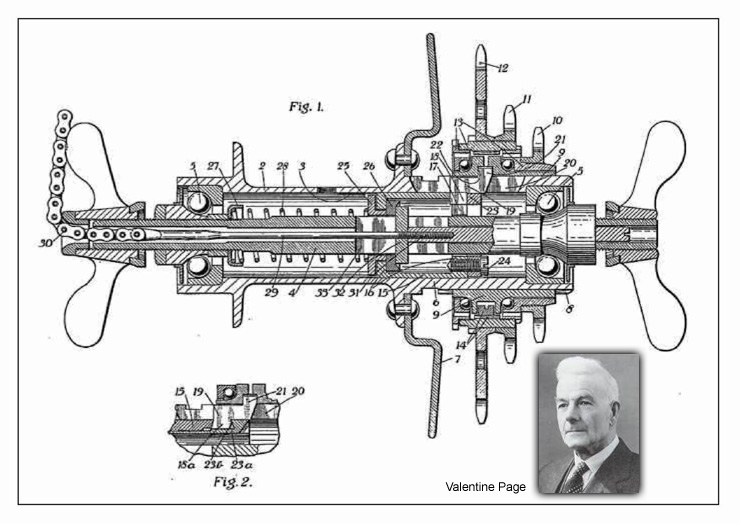
Diagram from Valentine Page's 1935 patent application (451,722) (Inset photograph of Valentine Page courtesy of Wikipedia)
Just six months later, the Triumph Company was advertising a TriVelox gear that incorporated these changes. As both the advertisement and patent application show, the cable for changing gear is now on the opposite side of the bicycle and the gear's working mechanism is enclosed in the barrel of the wheel hub. In addition, the advertisement shows the gear fitted to a frame with forward-facing drop-outs. Wayne Gillies, a member of the Veteran-Cycle Club, owns a New Hudson bicycle that is fitted with this type of gear, as shown below. Alex Lindsay, another member of the V-CC, owns a completely original and unrestored 1935 BSA Lady Back tandem which is also fitted with this 'second generation', A-model gear, even though the frame has rear-facing drop-outs. Photographs of Alex's gear, together with an image of a Lady Back tandem taken from a 1936 BSA catalogue, can be seen here.
In the following year, 1936, the Triumph Company was experiencing major financial problems and the bicycle and motorcycle divisions were both sold off. The bicycle business was sold to Coventry Bicycles Limited of Osborne Road in the Earlsdon area of Coventry, the manufacturers of the Three Spires brand of bicycle. Siegfried Bettmann, who had retired as Chairman of Triumph in 1933, had quickly formed a consortium to facilitate the sale, a consortium that included a man named Downes from Coventry Bicycles. Following its purchase of the Triumph bicycle business, Coventry Bicycles decided to create a subsidiary company to manufacture and market the TriVelox gear: the company was named TriVelox Gears Limited. Despite this change in ownership, production of the TriVelox gear did not move to Osborne Road along with Triumph bicycles but continued at the Priory Street factory[5].
Notes
1. There are excellent summaries of Bettmann's life and achievements in: Damien Kimberley. Coventry's Motorcycle Heritage. Stroud: The History Press, 2009, pages 117-120; and Peter Walters. The Story of Coventry. Stroud: The History Press, 2013, pages 202-203.
2. See, for example: Anthony Edward Harrison. 'The Origins and Growth of the UK Cycle Industry to 1900'. Journal of Transport History, 1985, pages 41-70; Roger Lloyd-Jones and M.J. Lewis. Raleigh and the British Bicycle Industry: An Economic and Business History, 1870-1960. Aldershot: Ashgate Publishing, 2000, Chapter 2; and David Thoms and Tom Donnelly. The Coventry Motor Industry: Birth to Renaissance? Aldershot, Ashgate Publishing, 2000, Chapter 2. Two examples of more accessible publications that give accounts of the early cycle industry in Coventry are: Cyclopedia: A History of the Bicycle. Coventry: Coventry Transport Museum, no date, but published in 2005 or later; and W.F. Grew.The Cycle Industry: Its Origin, History and Latest Developments. London: Pitman, 1921. Reprint, London: Forgotten Books, 2012.
3. The secondary sources on the history of bicycle manufacture in Coventry are extremely unreliable and contradictory: there is a real need for thorough research in this area based on primary sources. Damien Kimberley's 2015 book on Coventry's cycle manufacturers has gone a long way towards rectifying matters. A selected bibliography of writings on the cycle industry, with an emphasis on the industry in Coventry, may be seen here. The bibliography includes the publications given in footnote 2 and provides full details of the book by Damien Kimberley.
4. The spares and repairs departments were located in nearby Much Park Street. An undated spare parts catalogue for the gear, probably published by Triumph in the early-to-mid 1930s, gives the Much Park Street address. This spare parts catalogue, together with other material relating to the TriVelox gear, can be viewed by entering 'TriVelox', without the quotes, into the search box of the website of the Veteran-Cycle Club Library. According to a personal communication from a lady whose mother worked on the production of the TriVelox gear at Triumph during the 1930s, one of the production foremen was the future trade union leader Sir Jack Jones.
5. An announcement by Coventry Bicycles in the 2 March 1937 issue of The Bicycle stated: 'Manufacture of Triumph and Three Spires cycles is shortly to be transferred from the present factory in the Earlsdon district of Coventry to the old Triumph works in Priory-street, in the centre of the city... The TriVelox gear side is already in occupation of the other section of the [Priory Street] works.'
